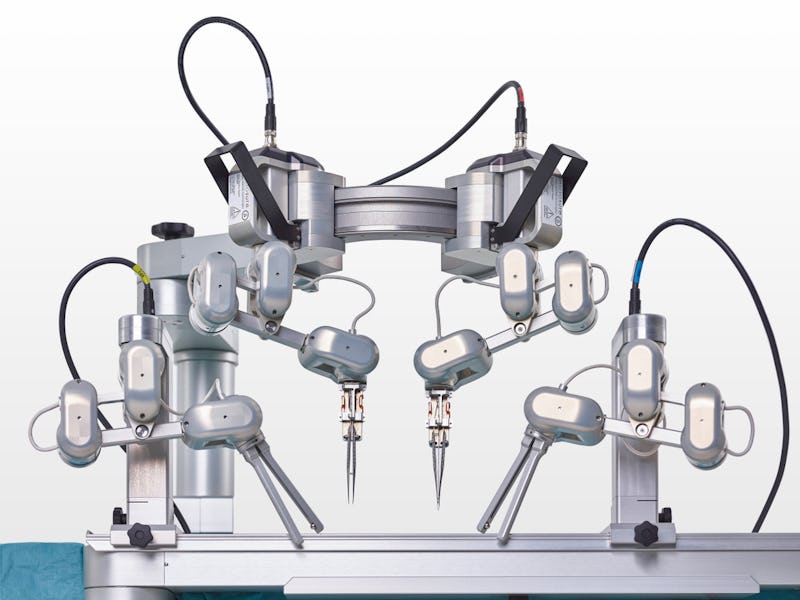Joysticks and foot pedals could be the future of "microsurgery"
In randomized trials patients went under the knife -- some with robots and some without. Scientists call it "supermicrosurgery."

The internet was charmed and baffled when the da Vinci Surgical System performed surgery on a grape in 2010, and since then the demand for small, precise surgical robots has only increased. Scientists are now looking to design robotic surgery systems that can perform supermicrosurgery (on the scale of only .3 to .8 millimeters, or .01 to .03 inches,) and a preclinical trial is the first to demonstrate how such technology could be feasible.
The study, published Tuesday in the journal Nature Communications, looks at two trial groups of women with breast cancer-related lymphedema having surgeries performed to connect lymphatic vessels in the arm to tiny veins nearby in order to drain lymph nodes. This surgery is one of many that have been developed in recent years to improve breast cancer care and transform it from a death sentence to a chronic illness and requires incredible dexterity on the part of the surgeon. The group of twenty women involved in this trial were randomized and assigned to either have the surgery completed manually by a surgeon or by a robot operated remotely by a surgeon.
The team behind the study hopes that they are experimenting with the future of microsurgery. "I think that in the future many robotic platforms will be used in every major hospital," says Tom van Mulken of Maastricht University in the Netherlands, speaking to Inverse via email. "The ones that are active in microsurgery should be able to use the platform as it is compatible with every operation microscope and with general microsurgical instruments. However, it is up to the hospitals and the market to choose out of the many robots that will come."
The robotic platform designed by the team for the study is called MUSA and consists of joystick-like forceps attached to the operating table and a foot pedal for the surgeon to manipulate as well as miniaturized arms that are designed to hold surgical tools. During the operation, the surgeon manipulates the forceps and that motion is mimicked and miniaturized by the robot. The foot pedal allows the surgeon to begin the operation as well as control for motion scaling and tremors.
Surgeons demonstrate how MUSA can be used to complete extremely small surgeries.
While the participants and the surgeons themselves could not be blinded to this experiment (for obvious reasons,) another team of blinded surgeons reviewed the results afterward to compare the two approaches. The evaluation found that both surgery models were fairly similar when it came to convenience and satisfaction from surgeons (though the manual surgery was slightly better) and that the manual surgery was still faster than the robot-assisted surgery. However, the authors note that as the trials progressed the MUSA surgery became quicker and quicker, suggesting it could be on track to meet or surpass the manual surgery speed in the future.
Following up with these patients three-months after the surgery, the team found both groups had no significant difference in how they scored their recovery, apart from two patients who underwent robot-assisted surgery and reported a post-surgical skin infection. The authors write that the infections were quickly addressed with oral antibiotics and that no severe effects occurred.
MUSA's first time in the field might not have been a roaring success, but it did demonstrate how a surgical platform like this could be used in such incredibly sensitive procedures. Going forward, the authors write that a larger sample size of patients, as well as surgeons, are needed to further validate their results and that they hope to conduct large, multicenter trials in the future.
"Our goal is to bring new possibilities in microsurgery by offering robot assistance," Dr. van Mulken tells Inverse. "This means that we have to test the system in well designed trials and that we have to be open to any feedback from patients, surgeons and other hospital staff.I think that the reason that we have come so far is because we had a good communication and teamwork between clinical and technical people. We have to stay curious, humble and open for new ideas."
Abstract: Advancements in reconstructive microsurgery have evolved into supermicrosurgery; connecting vessels with diameter between 0.3 and 0.8mm for reconstruction of lymphatic flow and vascularized tissue transplantation. Supermicrosurgery is limited by the precision and dexterity of the surgeon’s hands. Robot assistance can help overcome these human limitations, thereby enabling a breakthrough in supermicrosurgery. We report the first-in-human study of robot-assisted supermicrosurgery using a dedicated microsurgical robotic platform. A prospective randomized pilot study is conducted comparing robot-assisted and manual supermicrosurgical lymphatico-venous anastomosis (LVA) in treating breast cancer-related lymphedema. We evaluate patient outcome at 1 and 3 months post surgery, duration of the surgery, and quality of the anastomosis. At 3 months, patient outcome improves. Furthermore, a steep decline in duration of time required to complete the anastomosis is observed in the robot-assisted group (33–16 min). Here, we report the feasibility of robot-assisted supermicrosurgical anastomosis in LVA, indicating promising results for the future of reconstructive supermicrosurgery.